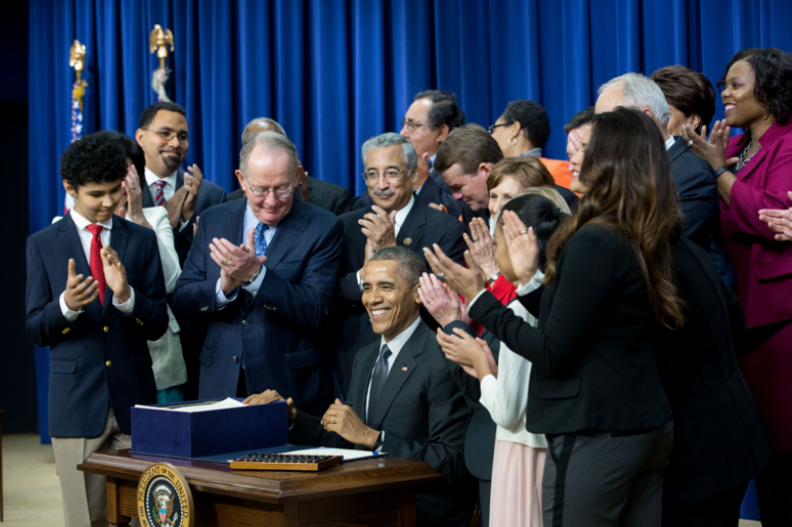Legislation Revises K-12 Federal Accountability Metrics
Author: Rick Phelan
Published: 12.15.15

Educators have long anticipated legislative action to update and revise the Federal government’s 2001 "No Child Left Behind’" act. The wait ended on December 10th when President Obama signed the Every Student Succeeds Act. This blog post summarizes key elements of the new federal framework for elementary and secondary education.
The newly signed Every Student Succeeds Act (ESSA) is a federal law that had bipartisan support. It was championed by Democratic representative Patty Murray from Washington and Republican representative Lamar Alexander from Tennessee. The ESSA framework has a number of important elements that will shape the future of education in Sonoma County. Among them:
- supports California’s implementation of Common Core State Standards
- offers guidance related to assessment practices
- shifts school accountability metrics to states
- streamlines and supports past K-12 initiatives
Connections with California Local Control Accountability Plans
The Every Student Succeeds Act affirms California’s use of Common Core State Standards and is a good match with accountability measures currently being considered by the California State Board of Education. Different from the rigid measures of No Child Left Behind (NCLB), the ESSA framework asks states to work with districts to offer a well-rounded program of instruction with “evidence-based action.” This element can work with California school district Local Control Accountability Plans, which are in their second second year of implementation and focus on eight state priority areas. Doing away with NCLB’s Adequate Yearly Progress mandates and establishing local control initiatives are clear signals that Federal legislators heard from state educational agencies and educators in the field.
Annual Assessments
The Every Student Succeeds Act specifies that states must assess students annually in mathematics and English language arts assessment between grades 3-8, and at least once in grades 9-12. California’s current practice of using Smarter Balanced Assessments for mathematics and English language arts fits with new administration requirements for grades 3-8 and 11. In the case of science, ESSA asks states to administer assessments at least once in each of the three grade spans: 3-5, 6-9, and 10-12. To meet this requirement, California will continue using its Standardized Testing and Reporting (STAR) science exams in grades 5, 8 and 10 until 2016-17, when the state plans to roll out a new exam that will measure Next Generation Science Standards.
Accountability for Student Sub Groups Continues
Under NCLB, districts were responsible for ‘disaggregating’ annual assessment data in English language arts and math by significant subgroups. With ESSA, this practice continues. Annual assessment data in English language arts and mathematics needs to be broken out to display the performance of economically disadvantaged students, English learners, students with disabilities, students by ethnicity and foster children. Different than NCLB, annual assessments for these subgroups are only one part of the picture. The new Federal system asks states to design an accountability system that includes annual assessments with other measures such as student engagement, school climate, access to and completion of advanced coursework, and school safety. The California State Board of Education is currently working to develop metrics that could serve this function. Under the new ESSA framework states are required to use their own metrics to evaluate and improve student learning for the bottom 5 percent of their schools. This will change program improvement activities that had been a hallmark of NCLB.
Other Areas of Support
The ESSA framework provides guidance to districts in other important areas. Some of these include:
- Educator Improvement—the framework provides resources to implement various activities to support educator professional development, induction, and recruitment
- English Learners—the framework requires States to develop statewide entrance and exit procedures for English learner programs
- Maintains and Strengthens Programs—the framework streamlines and reduces the number of existing federal programs while authorizing dedicated funding to support important priorities including: teacher quality, innovation, afterschool programs, increased access to STEM education, arts education, and literacy.
Related Resources and Information
President Bush Describing 2001 Elementary and Secondary Education Act (YouTube Video)
President Obama Expressing Importance of Alternate Accountability Measures (YouTube Video)
California Leads Drive to Reverse Focus on Standardized Tests (EdSource Article)
2015 SBAC Results- Sonoma County Schools
New Education Law Will Bring Flexibility Sonoma County Educators Say (Press Democrat)
STAR Legacy Reports- Sonoma County Schools
Blog: Technology for Learners

